Zircon U-Pb and Fission-Track Chronology of the Kaiyang Phosphate Deposit in the Yangtze Block: Implications for the Rodinia Supercontinent Splitting and Subsequent Thermal Events
Abstract
:1. Introduction
2. Regional Geological Background
3. Petrography
4. Analytical Methods
4.1. Whole-Rock Geochemical Analysis
4.2. Zircon LA-ICP-MS U-Pb Dating
4.3. Zircon Fission-Track Analysis
5. Analytical Results
5.1. Whole-Rock Geochemical Analysis
5.2. Zircon LA-ICP-MS U-Pb Dating
5.3. Zircon Fission-Track Analysis
6. Discussion
6.1. Origin and Age Distribution of Zircon in the Phosphorite-Bearing Rocks of the Doushantuo Formation in the Kaiyang Area

6.2. The Response of the Neoproterozoic Magmatic Events in the Kaiyang Region to the Splitting of the Rodinia Supercontinent
6.3. The Mineralization Age of Phosphate Deposits in the Doushantuo Formation, Kaiyang
6.4. The Structural and Thermal Events after Phosphorite Mineralization in Kaiyang
7. Conclusions
- (1)
- The Doushantuo Formation in the Kaiyang area shows a stratigraphic sequence from top to bottom consisting of dolostone, phosphorite, and sandstone, with the primary mineral in the phosphorite being collophane, which contains P2O5 ranging from 30.1% to 34.8% and rare earth element contents between 117.01–266.55 ppm. The P2O5 content displays a significant positive correlation with the REE and Y elements, indicating that the rare earth elements are primarily hosted in collophane.
- (2)
- The detrital zircons in the phosphorite-bearing rocks are predominantly of magmatic origin, with LA-ICP-MS U-Pb chronology indicating a major magmatic peak at ~820 Ma, followed by secondary peaks at ~2500 Ma, ~2000–1800 Ma, ~880 Ma, and ~780 Ma. These ages, in conjunction with previous studies, suggest that the oldest ages (~2500 Ma and ~2000–1800 Ma) provide direct evidence of a Paleoproterozoic crystalline basement in the central and southern of Yangtze Block. The Neoproterozoic ages correlate with the assembly (~880 Ma) and continued breakup (820–780 Ma) of the Rodinia supercontinent. The youngest zircon ages of the Doushantuo Formation in Kaiyang, at 594 ± 9 Ma and 529 ± 22 Ma, set a lower limit for the formation age of the phosphorite rocks, thus indicating they formed at least as late as 594 Ma (which is even later than 529 Ma).
- (3)
- The zircon fission-track thermochronology, when integrated with previous research, indicated multiple episodes of tectonic uplift in the Kaiyang area after the formation of the phosphorite -bearing rocks. Magmatic events around 501–489 Ma and ~366 Ma are associated with the regional Caledonian movement, which culminated in the formation of the Qianzhong Uplift that is centered in Kaiyang. When dissecting earlier strata, the age range of 52–39 Ma was found to correspond to the Himalayan tectonic events in Guizhou, which resulted in the formation of numerous NNW-oriented folds.
Supplementary Materials
Author Contributions
Funding
Data Availability Statement
Acknowledgments
Conflicts of Interest
References
- Li, X.H.; Li, Z.X.; Ge, W.C.; Zhou, H.W.; Li, W.X.; Liu, Y.; Wingate, M. Neoproterozoic granitoids in South China: Crustal melting above a mantle plume at ca. 825 Ma? Precambrian Res. 2003, 122, 45–83. [Google Scholar] [CrossRef]
- Wang, J.; Li, Z.X. History of Neoproterozoic rift basins in South China: Implications for Rodinia Break-up. Precambrian Res. 2003, 122, 141–158. [Google Scholar] [CrossRef]
- Jiang, X.S.; Wang, J.; Cui, X.Z.; Zhuo, J.W.; Xiong, G.Q.; Lu, J.Z.; Liu, J.H. Zircon SHRIMP U-Pb geochronology of the Neoproterozoic Chengjiang Formation in central Yunnan Province (SW China) and its geological significance. Sci. China Earth Sci. 2012, 55, 1815–1826. [Google Scholar] [CrossRef]
- Pan, G.T.; Xiao, Q.H.; Lu, S.N.; Deng, J.F.; Feng, Y.M.; Zhang, K.X.; Zhang, Z.Y.; Wang, F.G.; Xing, G.F.; Hao, G.J.; et al. Subdivision of tectonic units in China. Geol. China 2009, 36, 1–28. (In Chinese) [Google Scholar]
- Wang, L.J.; Zhang, K.X.; Lin, S.F.; He, W.H.; Kou, X.H.; Xiao, H.Z. Turbidite record of a Neoproterozoic active continental margin in the West Cathaysia terrane, South China: Implications for the relationships between the Yangtze and Cathaysia blocks and their positions in Rodinia. Precambrian Res. 2019, 337, 105457. [Google Scholar] [CrossRef]
- Zou, H.; Li, Q.L.; Bagas, L.; Wang, X.C.; Chen, A.Q.; Li, X.H. A Neoproterozoic low-δ18O magmatic ring around South China: Implications for configuration and breakup of Rodinia supercontinent. Earth Planet. Sci. Lett. 2021, 575, 117196. [Google Scholar] [CrossRef]
- Huang, C.C.; Zou, H.; Bagas, L.; Chen, H.F.; Xiao, B.; Jiang, X.W.; Li, M.; Hu, C.H.; Yu, L.M. Mid-Neoproterozoic tectonic evolution of the northern margin of the Yangtze Block, South China: New insights from high-temperature magma events. Lithos 2022, 420–421, 106711. [Google Scholar] [CrossRef]
- Kennedy, M.J.; Runnegar, B.; Prave, A.R.; Hoffmann, K.H.; Arthur, M.A. Two or four Neoproterozoic glaciations? Geology 1998, 26, 1059–1063. [Google Scholar] [CrossRef]
- Hoffman, P.F.; Abbot, D.S.; Ashkenazy, Y.; Benn, D.; Brocks, J.; Cohen, P.; Cox, G.; Creveling, J.; Donnadieu, Y.; Erwin, D.; et al. Snowball earth climate dynamics and Cryogenian geology-geobiology. Sci. Adv. 2017, 3, e1600983. [Google Scholar] [CrossRef]
- Shi, C.H. Formation of Phosphorite Deposit, Break-Up of Rodinia Supercontinent and Biology Explosion—A Case Study of Wengan, Kaiyang and Zhijin Phosphorite Deposits of Guizhou Province. Ph.D. Thesis, Institute of Geochemistry, Chinese Academy of Science, Guiyang, China, 2005. (In Chinese). [Google Scholar]
- Knoll, A.H.; Xiao, S.H. On the age of the Doushantuo Formation. Acta Micropalaeontol. Sin. 1999, 16, 225–236. [Google Scholar]
- McDougall, I.; Harrison, T.M. Geochronology and Thermochronology by the 40Ar/39Ar Method; Oxford University Press: Oxford, UK, 1999. [Google Scholar] [CrossRef]
- Barfod, G.; Albarède, F.; Knoll, A.; Xiao, S.H.; Frei, R.; Baker, J. Implications for the Neoproterozoic Biological and Climatic History from Dating of the Doushantuo Phosphorites, S. China. AGU Fall Meet. Abstr. 2002, 1, B71B-0737. [Google Scholar]
- Chen, D.F.; Dong, W.; Zhu, B.; Chen, X. Pb-Pb ages of Neoproterozoic Doushantuo phosphorites in South China: Constraints on early metazoan evolution and glaciation events. Precambrian Res. 2004, 132, 123–132. [Google Scholar] [CrossRef]
- Chew, D.M.; Spikings, R.A. Geochronology and Thermochronology Using Apatite: Time and Temperature, Lower Crust to Surface. Elements 2015, 11, 189–194. [Google Scholar] [CrossRef]
- Hawkesworth, C.; Kemp, A.I.S. Using hafnium and oxygen isotopes in zircons to unravel the record of crustal evolution. Chem. Geol. 2006, 226, 144–162. [Google Scholar] [CrossRef]
- Kemp, A.I.S.; Wilde, S.; Hawkesworth, C.; Coath, C.D.; Nemchin, A.; Pidgeon, R.; Vervoort, J.; Dufrane, S.A. Hadean crustal evolution revisited: New constraints from Pb–Hf isotope systematics of the Jack Hills zircons. Earth Planet. Sci. Lett. 2010, 296, 45–56. [Google Scholar] [CrossRef]
- Wang, H.S.; Cai, X.L.; Lei, L.F. Analysis on structural characteristics in Yangshui mining area of Kaiyang phosphate Mine, Central Guizhou. Geol. Chem. Miner. 2017, 39, 90–95. (In Chinese) [Google Scholar]
- Wang, Z.P.; Zhang, Y.G.; Du, Y.S.; Chen, G.Y.; Liu, J.Z.; Xu, Y.Y.; Tan, D.W.; Li, L.; Wang, D.F.; Wu, W.M. Reconstruction of quantitative lithofacies palaeogeography of the Sinian Doushantuo Age of phosphorite depositional zone in Kaiyang area, central Guizhou Province. J. Palaeogeogr. (Chin. Ed.) 2016, 18, 399–410. (In Chinese) [Google Scholar]
- Siivola, J.; Schmid, R. Recommendations by the IUGS Subcommission on the Systematics of Metamorphic Rocks: Web version 01.02.07. Geology 2007. [Google Scholar]
- Vermeesch, P. IsoplotR: A free and open toolbox for geochronology. Geosci. Front. 2018, 9, 1479–1493. [Google Scholar] [CrossRef]
- Hurford, A.J. Standardization of fission track dating calibration: Recommendation by the Fission Track Working Group of the I.U.G.S. Subcommission on Geochronology. Chem. Geol. Isot. Geosci. Sect. 1990, 80, 171–178. [Google Scholar] [CrossRef]
- Galbraith, R.F. On statistical models for fission track counts. J. Int. Assoc. Math. Geol. 1981, 13, 471–478. [Google Scholar] [CrossRef]
- Brandon, M.T. Decomposition of fission-track grain-age distributions. Am. J. Sci. 1992, 292, 535–564. [Google Scholar] [CrossRef]
- Rudnick, R.; Gao, S. Composition of the Continental Crust. Treatise Geochem. 2003, 3, 1–64. [Google Scholar] [CrossRef]
- Mclennan, S.M. Rare earth elements in sedimentary rocks: Influence of provenance and sedimentary processes. Rev. Mineral. Geochem. 1989, 21, 169–200. [Google Scholar]
- Sun, S.S.; Mcdonough, W.F. Chemical and isotopic systematics of ocean basalts: Implications for mantle composition and processes, in Magmatism in the Ocean Basins. Geol. Soc. Lond. Spec. Publ. 1989, 423, 13–345. [Google Scholar]
- Watson, E.B.; Wark, D.A.; Thomas, J.B. Crystallization thermometers for zircon and rutile. Contrib. Mineral. Petrol. 2006, 151, 413. [Google Scholar] [CrossRef]
- Green, P.F.; Duddy, I.R.; Laslett, G.M.; Hegarty, K.A.; Gleadow, A.J.W.; Lovering, J.F. Thermal annealing of fission tracks in apatite 4. Quantitative modelling techniques and extension to geological timescales. Chem. Geol. Isot. Geosci. Sect. 1989, 79, 155–182. [Google Scholar] [CrossRef]
- McDannell, K.T. Notes on statistical age dispersion in fission-track datasets: The chi-square test, annealing variability, and analytical considerations. EarthArXiv 2020, 1–4. [Google Scholar] [CrossRef]
- Galbraith, R.F.; Laslett, G.M. Statistical models for mixed fission track ages. Nucl. Tracks Radiat. Meas. 1993, 21, 459–470. [Google Scholar] [CrossRef]
- Gehrels, G. Detrital Zircon U-Pb Geochronology Applied to Tectonics. Annu. Rev. Earth Planet. Sci. 2014, 42, 127–149. [Google Scholar] [CrossRef]
- Olierook, H.; Jourdan, F.; Merle, R. Age of the Barremian–Aptian boundary and onset of the Cretaceous Normal Superchron. Earth-Sci. Rev. 2019, 197, 102906. [Google Scholar] [CrossRef]
- Rubatto, D. Zircon: The Metamorphic Mineral. Rev. Mineral. Geochem. 2017, 83, 261–295. [Google Scholar] [CrossRef]
- Hoskin, P.W.O.; Schaltegger, U. The Composition of Zircon and Igneous and Metamorphic Petrogenesis. Rev. Mineral. Geochem. 2003, 53, 27–62. [Google Scholar] [CrossRef]
- Li, C.M. A Review on the Minerageny and Situ Microanalytical Dating Techniques of Zircons. North China Geol. 2009, 32, 161–174. (In Chinese) [Google Scholar]
- Zheng, Y.F.; Zhang, S.B. Formation and evolution of Precambrian continental crust in South China. Chin. Sci. Bull. 2007, 52, 1–12. [Google Scholar] [CrossRef]
- Sun, M.; Chen, N.S.; Zhao, G.C.; Wilde, S.; Ye, K.; Guo, J.H.; Chen, Y.; Yuan, C. U-Pb zircon and Sm-Nd isotopic study of the Huangtuling granulite, Dabie-Sulu belt, China: Implication for the paleoproterozoic tectonic history of the Yangtze Craton. Am. J. Sci. 2008, 308, 469–483. [Google Scholar] [CrossRef]
- Zhang, L.J.; Ma, C.Q.; Wang, L.X.; She, Z.B.; Wang, S.M. Discovery of Paleoproterozoic rapakivi granite on the northern margin of the Yangtze block and its geological significance. Chin. Sci. Bull. 2011, 56, 306–318. [Google Scholar] [CrossRef]
- Wu, Y.B.; Gao, S.; Zhang, H.F.; Zheng, J.P.; Liu, X.C.; Wang, H.; Gong, H.J.; Zhou, L.; Yuan, H.L. Geochemistry and zircon U–Pb geochronology of Paleoproterozoic arc related granitoid in the Northwestern Yangtze Block and its geological implications. Precambrian Res. 2012, 200–203, 26–37. [Google Scholar] [CrossRef]
- Chen, K.; Gao, S.; Wu, Y.B.; Guo, J.L.; Hu, Z.C.; Liu, Y.S.; Zong, K.Q.; Liang, Z.W.; Geng, X.L. 2.6–2.7 Ga crustal growth in Yangtze craton, South China. Precambrian Res. 2013, 224, 472–490. [Google Scholar] [CrossRef]
- Wu, Y.B.; Zhou, G.Y.; Gao, S.; Liu, X.C.; Qin, Z.W.; Wang, H.; Yang, J.Z.; Yang, S.H. Petrogenesis of Neoarchean TTG rocks in the Yangtze Craton and its implication for the formation of Archean TTGs. Precambrian Res. 2014, 254, 73–86. [Google Scholar] [CrossRef]
- Hui, B.; Dong, Y.P.; Cheng, C.; Long, X.P.; Liu, X.M.; Yang, Z.; Sun, S.S.; Zhang, F.F.; Varga, J. Zircon U–Pb chronology, Hf isotope analysis and whole-rock geochemistry for the Neoarchean-Paleoproterozoic Yudongzi complex, northwestern margin of the Yangtze craton, China. Precambrian Res. 2017, 301, 65–85. [Google Scholar] [CrossRef]
- Chen, Q.; Sun, M.; Zhao, G.C.; Zhao, J.H.; Zhu, W.L.; Long, X.P.; Wang, J. Episodic crustal growth and reworking of the Yudongzi terrane, South China: Constraints from the Archean TTGs and potassic granites and Paleoproterozoic amphibolites. Lithos 2019, 326–327, 1–18. [Google Scholar] [CrossRef]
- Lin, W.L.; Gao, S.; Zhang, B.R.; Zhou, L.; Zhang, H.F. Early Precambrian crustal evolution at the northern margin of the Yangtze Craton—Element and isotope geochemical constraints of the Houhe Complex. Mineral. Petrol. 1997, 4, 27–33. (In Chinese) [Google Scholar] [CrossRef]
- Qiu, Y.M.; Gao, S.; McNaughton, N.J.; Groves, D.I.; Ling, W.L. First evidence of >3.2 Ga continental crust in the Yangtze craton of south China and its implications for Archean crustal evolution and Phanerozoic tectonics. Geology 2000, 28, 11–14. [Google Scholar] [CrossRef]
- Qiu, X.F.; Zhao, X.; Yang, H.R.; Wei, Y.; Wu, N.; Lu, S.; Jang, T.; Peng, L. Paleoproterozoic metamorphic event in the nucleus of the Yangtze craton: Evidence from U-Pb geochronology of the metamorphic zircons from the khondalite. Geol. Bull. China 2017, 36, 706–714. [Google Scholar]
- Wu, Y.B.; Gao, S.; Zhang, H.F.; Yang, S.H.; Liu, X.C.; Jiao, W.F.; Liu, Y.S.; Yuan, H.L.; Gong, H.J.; He, M.C. U-Pb age, trace-element, and Hf-isotope compositions of zircon in a quartz vein from eclogite in the western Dabie Mountains: Constraints on fluid flow during early exhumation of ultrahigh-pressure rocks. Am. Mineral. 2009, 94, 303–312. [Google Scholar] [CrossRef]
- Jiao, W.F.; Wu, Y.B.; Yang, S.H.; Peng, M.; Wang, J. The oldest basement rock in the Yangtze Craton revealed by zircon U-Pb age and Hf isotope composition. Sci. China Ser. D Earth Sci. 2009, 52, 1393–1399. [Google Scholar] [CrossRef]
- Guo, J.L.; Gao, S.; Wu, Y.B.; Li, M.; Chen, K.; Hu, Z.C.; Liang, Z.W.; Liu, Y.S.; Zhou, L.; Zong, K.Q.; et al. 3.45 Ga granitic gneisses from the Yangtze Craton, South China: Implications for Early Archean crustal growth. Precambrian Res. 2014, 242, 82–95. [Google Scholar] [CrossRef]
- Han, Q.S.; Peng, S.B.; Polat, A.; Kusky, T.; Deng, H.; Wu, T.Y. A ca.2.1 Ga Andean-type margin built on metasomatized lithosphere in the northern Yangtze craton, China: Evidence from high-Mg basalts and andesites. Precambrian Res. 2018, 309, 309–324. [Google Scholar] [CrossRef]
- Liu, H.Y.; Xia, B.; Zhang, Y.Q. The study presents the SHRIMP dating of zircon from the Na-rich alkaline rocks in Maomao Gully, Panxi, Huali, and discusses its geological significance. Chin. Sci. Bull. 2004, 49, 1431–1438. (In Chinese) [Google Scholar]
- Sun, W.H.; Zhou, M.F.; Gao, J.F.; Yang, Y.H.; Zhao, X.F.; Zhao, J.H. Detrital zircon U–Pb geochronological and Lu–Hf isotopic constraints on the Precambrian magmatic and crustal evolution of the western Yangtze Block, SW China. Precambrian Res. 2009, 172, 99–126. [Google Scholar] [CrossRef]
- Zhao, X.F.; Zhou, M.F.; Li, J.W.; Sun, M.; Gao, J.F.; Sun, W.H.; Yang, J.H. Late Paleoproterozoic to early Mesoproterozoic Dongchuan Group in Yunnan, SW China: Implications for tectonic evolution of the Yangtze Block. Precambrian Res. 2010, 182, 57–69. [Google Scholar] [CrossRef]
- Zhao, T.Y.; Li, J.; Liu, G.C.; Cawood, P.A.; Zi, J.W.; Wang, K.; Feng, Q.L.; Hu, S.B.; Zeng, W.T.; Zhang, H. Petrogenesis of Archean TTGs and potassic granites in the southern Yangtze Block: Constraints on the early formation of the Yangtze Block. Precambrian Res. 2020, 347, 105848. [Google Scholar] [CrossRef]
- Cui, X.Z.; Wang, J.; Wang, X.C.; Wilde, S.A.; Ren, G.M.; Li, S.J.; Deng, Q.; Ren, F.; Liu, J.P. Early crustal evolution of the Yangtze Block: Constraints from zircon U-Pb-Hf isotope systematics of 3.1–1.9 Ga granitoids in the Cuoke Complex, SW China. Precambrian Res. 2021, 357, 106155. [Google Scholar] [CrossRef]
- Greentree, M.R.; Li, Z.X. The oldest known rocks in south–western China: SHRIMP U–Pb magmatic crystallisation age and detrital provenance analysis of the Paleoproterozoic Dahongshan Group. J. Asian Earth Sci. 2008, 33, 289–302. [Google Scholar] [CrossRef]
- Wang, L.J.; Yu, J.H.; Griffin, W.L.; O’Reilly, S.Y. Early crustal evolution in the western Yangtze Block: Evidence from U–Pb and Lu–Hf isotopes on detrital zircons from sedimentary rocks. Precambrian Res. 2012, 222–223, 368–385. [Google Scholar] [CrossRef]
- Chen, W.T.; Zhou, M.F.; Zhao, X.F. Late Paleoproterozoic sedimentary and mafic rocks in the Hekou area, SW China: Implication for the reconstruction of the Yangtze Block in Columbia. Precambrian Res. 2013, 231, 61–77. [Google Scholar] [CrossRef]
- Hoskin, P.W.O. Trace-element composition of hydrothermal zircon and the alteration of Hadean zircon from the Jack Hills, Australia. Geochim. Et Cosmochim. Acta 2005, 69, 637–648. [Google Scholar] [CrossRef]
- McMenamin, M.A.S.; McMenamin, D.L.S. The Emergence of Animals the Cambrian Breakthrough; Columbia University Press: New York, NY, USA, 1990. [Google Scholar]
- Moores, E.M. Southwest U.S.-East Antarctic (SWEAT) connection: A hypothesis. Geology 1991, 19, 425–428. [Google Scholar] [CrossRef]
- Hoffman, P.F. Did the Breakout of Laurentia Turn Gondwanaland Inside-Out? Science 1991, 252, 1409–1412. [Google Scholar] [CrossRef]
- Wang, X.L.; Zhou, J.C.; Griffin, W.L.; Wang, R.C.; Qiu, J.S.; O’Reilly, S.Y.; Xu, X.S.; Liu, X.M.; Zhang, G.L. Detrital zircon geochronology of Precambrian basement sequences in the Jiangnan orogen: Dating the assembly of the Yangtze and Cathaysia Blocks. Precambrian Res. 2007, 159, 117–131. [Google Scholar] [CrossRef]
- Sun, L.; Wang, W.; Pandit, M.K.; Lu, G.M.; Xue, E.K.; Huang, B.; Zhang, Y.; Jin, W.; Tian, Y. Geochemical and detrital zircon age constraints on Meso- to Neoproterozoic sedimentary basins in the southern Yangtze Block: Implications on Proterozoic geodynamics of South China and Rodinia configuration. Precambrian Res. 2022, 378, 106779. [Google Scholar] [CrossRef]
- Ling, W.L.; Gao, S.; Zhang, B.R.; Li, H.M.; Liu, Y.; Cheng, J.P. Neoproterozoic tectonic evolution of the northwestern Yangtze craton, South China: Implications for amalgamation and break-up of the Rodinia Supercontinent. Precambrian Res. 2003, 122, 111–140. [Google Scholar] [CrossRef]
- Sun, L.; Wang, W.; Lu, G.M.; Xue, E.K.; Huang, S.F.; Pandit, M.K.; Huang, B.; Tong, X.R.; Tian, Y.; Zhang, Y. Neoproterozoic geodynamics of South China and implications on the Rodinia configuration: The Kunyang Group revisited. Precambrian Res. 2021, 363, 106338. [Google Scholar] [CrossRef]
- Zhu, W.G.; Zhong, H.; Li, X.H.; Deng, H.L.; He, D.F.; Wu, K.W.; Bai, Z.J. SHRIMP zircon U–Pb geochronology, elemental, and Nd isotopic geochemistry of the Neoproterozoic mafic dykes in the Yanbian area, SW China. Precambrian Res. 2008, 164, 66–85. [Google Scholar] [CrossRef]
- Huang, X.L.; Xu, Y.G.; Li, X.H.; Li, W.X.; Lan, J.B.; Zhang, H.H.; Liu, Y.S.; Wang, Y.B.; Li, H.Y.; Luo, Z.Y.; et al. Petrogenesis and tectonic implications of Neoproterozoic, highly fractionated A-type granites from Mianning, South China. Precambrian Res. 2008, 165, 190–204. [Google Scholar] [CrossRef]
- Zhou, M.F.; Kennedy, A.; Sun, M.; Malpas, J.; Lesher, M. Neoproterozoic Arc-Related Mafic Intrusions along the Northern Margin of South China: Implications for the Accretion of Rodinia. J. Geol. 2002, 110, 611–618. [Google Scholar] [CrossRef]
- Zhao, J.H.; Zhou, M.F.; Yan, D.P.; Zheng, J.P.; Li, J.W. Reappraisal of the ages of Neoproterozoic strata in South China: No connection with the Grenvillian orogeny. Geology 2011, 39, 299–302. [Google Scholar] [CrossRef]
- Wang, Y.J.; Zhang, A.M.; Cawood, P.A.; Fan, W.M.; Xu, J.F.; Zhang, G.W.; Zhang, Y.Z. Geochronological, geochemical and Nd–Hf–Os isotopic fingerprinting of an early Neoproterozoic arc–back-arc system in South China and its accretionary assembly along the margin of Rodinia. Precambrian Res. 2013, 231, 343–371. [Google Scholar] [CrossRef]
- Zheng, Y.F.; Zhang, S.B.; Zhao, Z.F.; Wu, Y.B.; Li, X.H.; Li, Z.X.; Wu, F.Y. Contrasting zircon Hf and O isotopes in the two episodes of Neoproterozoic granitoids in South China: Implications for growth and reworking of continental crust. Lithos 2007, 96, 127–150. [Google Scholar] [CrossRef]
- Zheng, Y.F.; Wu, R.X.; Wu, Y.B.; Zhang, S.B.; Yuan, H.L.; Wu, F.Y. Rift melting of juvenile arc-derived crust: Geochemical evidence from Neoproterozoic volcanic and granitic rocks in the Jiangnan Orogen, South China. Precambrian Res. 2008, 163, 351–383. [Google Scholar] [CrossRef]
- Cui, X.Z.; Jiang, X.S.; Wang, J.; Zhuo, J.W.; Jiang, Z.F.; Wu, H.; Deng, Q.; Wei, Y.N. New evidence for the formation age of basalts from the lowermost Chengjiang formation in the western Yangtze block and its geological implications. Acta Petrol. Et Mineral. 2015, 34, 1–13. (In Chinese) [Google Scholar]
- Dong, S.W.; Zhang, Y.S.; Gao, R.; Su, J.B.; Liu, M.; Li, J.H. A possible buried Paleoproterozoic collisional orogen beneath central South China: Evidence from seismic-reflection profiling. Precambrian Res. 2015, 264, 1–10. [Google Scholar] [CrossRef]
- Spencer, C.; Kirkland, C.; Taylor, R. Strategies towards statistically robust interpretations of in situ U–Pb zircon geochronology. Geosci. Front. 2015, 7, 581–589. [Google Scholar] [CrossRef]
- Xiao, S.H.; Knoll, A.H.; Yuan, X.L. Morphological reconstruction of Miaohephyton bifurcatum, a possible brown alga from the Neoproterozoic Doushantuo Formation, South China. J. Paleontol. 1998, 72, 1072–1086. [Google Scholar] [CrossRef]
- Reinhard, C.T.; Planavsky, N.J.; Gill, B.C.; Ozaki, K.; Robbins, L.J.; Lyons, T.W.; Fischer, W.W.; Wang, C.J.; Cole, D.B.; Konhauser, K.O. Evolution of the global phosphorus cycle. Nature 2017, 541, 386–389. [Google Scholar] [CrossRef]
- Cox, G.M.; Lyons, T.W.; Mitchell, R.N.; Hasterok, D.; Gard, M. Linking the rise of atmospheric oxygen to growth in the continental phosphorite inventory. Earth Planet. Sci. Lett. 2018, 489, 28–36. [Google Scholar] [CrossRef]
- Condon, D.; Zhu, M.Y.; Bowring, S.; Wang, W.; Yang, A.H.; Jin, Y.G. U-Pb Ages from the Neoproterozoic Doushantuo Formation, China. Science 2005, 308, 95–98. [Google Scholar] [CrossRef]
- Liu, P.J.; Yin, C.Y.; Gao, L.Z.; Tang, F.; Chen, S.M. New material of microfossils from the Ediacaran Doushantuo Formation in the Zhangcunping area, Yichang, Hubei Province and its zircon SHRIMP U-Pb age. Chin. Sci. Bull. 2009, 54, 1058–1064. [Google Scholar] [CrossRef]
- Zhu, B.; Becker, H.; Jiang, S.Y.; Pi, D.H.; Fischer Gödde, M.; Yang, J.H. Re–Os geochronology of black shales from the Neoproterozoic Doushantuo Formation, Yangtze platform, South China. Precambrian Res. 2013, 225, 67–76. [Google Scholar] [CrossRef]
- Zhou, C.M.; Li, X.H.; Xiao, S.H.; Lan, Z.W.; Ouyang, Q.; Guan, C.G.; Chen, Z.H.E. A new SIMS zircon U–Pb date from the Ediacaran Doushantuo Formation: Age constraint on the Weng’an biota. Geol. Mag. 2017, 154, 1193–1201. [Google Scholar] [CrossRef]
- Yang, C.; Rooney, A.D.; Condon, D.J.; Li, X.H.; Grazhdankin, D.V.; Bowyer, F.T.; Hu, C.L.; Macdonald, F.A.; Zhu, M.Y. The tempo of Ediacaran evolution. Sci. Adv. 2021, 7, eabi9643. [Google Scholar] [CrossRef]
- Chen, Y.Q.; Jiang, S.Y.; Ling, H.F.; Yang, J.H. Pb–Pb dating of black shales from the Lower Cambrian and Neoproterozoic strata, South China. Geochemistry 2009, 69, 183–189. [Google Scholar] [CrossRef]
- Hu, R.Z.; Peng, J.T.; Ma, D.S.; Su, W.C.; Shi, C.H.; Bi, X.W.; Tu, G.C. Epoch of large-scale low temperature mineralizations in southwestern Yangtze massif. Miner. Depos. 2007, 6, 583–596. (In Chinese) [Google Scholar]
- Brandon, M.T.; Roden Tice, M.K.; Garver, J.I. Late Cenozoic exhumation of the Cascadia accretionary wedge in the Olympic Mountains, northwest Washington State. GSA Bull. 1998, 110, 985–1009. [Google Scholar] [CrossRef]
- Wang, Y.D.; Zheng, J.J.; Zhang, W.L.; Li, S.Y.; Liu, X.W.; Yang, X.; Liu, Y.H. Cenozoic uplift of the Tibetan Plateau: Evidence from the tectonic–sedimentary evolution of the western Qaidam Basin. Geosci. Front. 2012, 3, 175–187. [Google Scholar] [CrossRef]
- Shi, G.Z.; Soares, C.J.; Shen, C.B.; Wang, H.; Yang, C.Q.; Liang, C.; Liu, M.H. Combined detrital zircon fission track and U-Pb dating of the Late Paleozoic to Early Mesozoic sandstones in the Helanshan, western Ordos fold-thrust belt: Constraints for provenance and exhumation history. J. Geodyn. 2019, 130, 57–71. [Google Scholar] [CrossRef]
- Qiu, L.; Yan, D.P.; Zhou, M.F.; Gao, J.F.; Tang, S.L.; Barnes, M. Geochemistry and U-Pb zircon age of Late Triassic volcanogenic sediments in the central Yangtze Block: Origin and tectonic implications. Neues Jahrb. Für Mineral. Abh. J. Mineral. Geochem. 2015, 192, 211–227. [Google Scholar] [CrossRef]
- Wang, Y.J.; Fan, W.M.; Cawood, P.; Ji, S.C.; Peng, T.P.; Chen, X.Y. Indosinian high-strain deformation for the Yunkaidashan tectonic belt, south China: Kinematics and 40Ar/39Ar geochronological constraints. Tectonics 2007, 26, TC6008. [Google Scholar] [CrossRef]
- Wang, J.L.; Lin, F.C.; Hou, L.; Zhang, J.R.; Peng, Z.; Zhu, S.B.; Wu, S.Y. Characteristics and metallogenic significance of fluid inclusions in the Nibao gold deposit, Guizhou. Bull. Mineral. Petrol. Geochem. 2014, 33, 688–699. (In Chinese) [Google Scholar] [CrossRef]
- Yang, K.G.; Li, X.G.; Dai, C.G. Superimposition deformation controlled and adjusted by faults: An example from Yanshanian structural deformation in Guizhou province. Bull. Geol. Sci. Technol. 2012, 31, 50–56. (In Chinese) [Google Scholar]
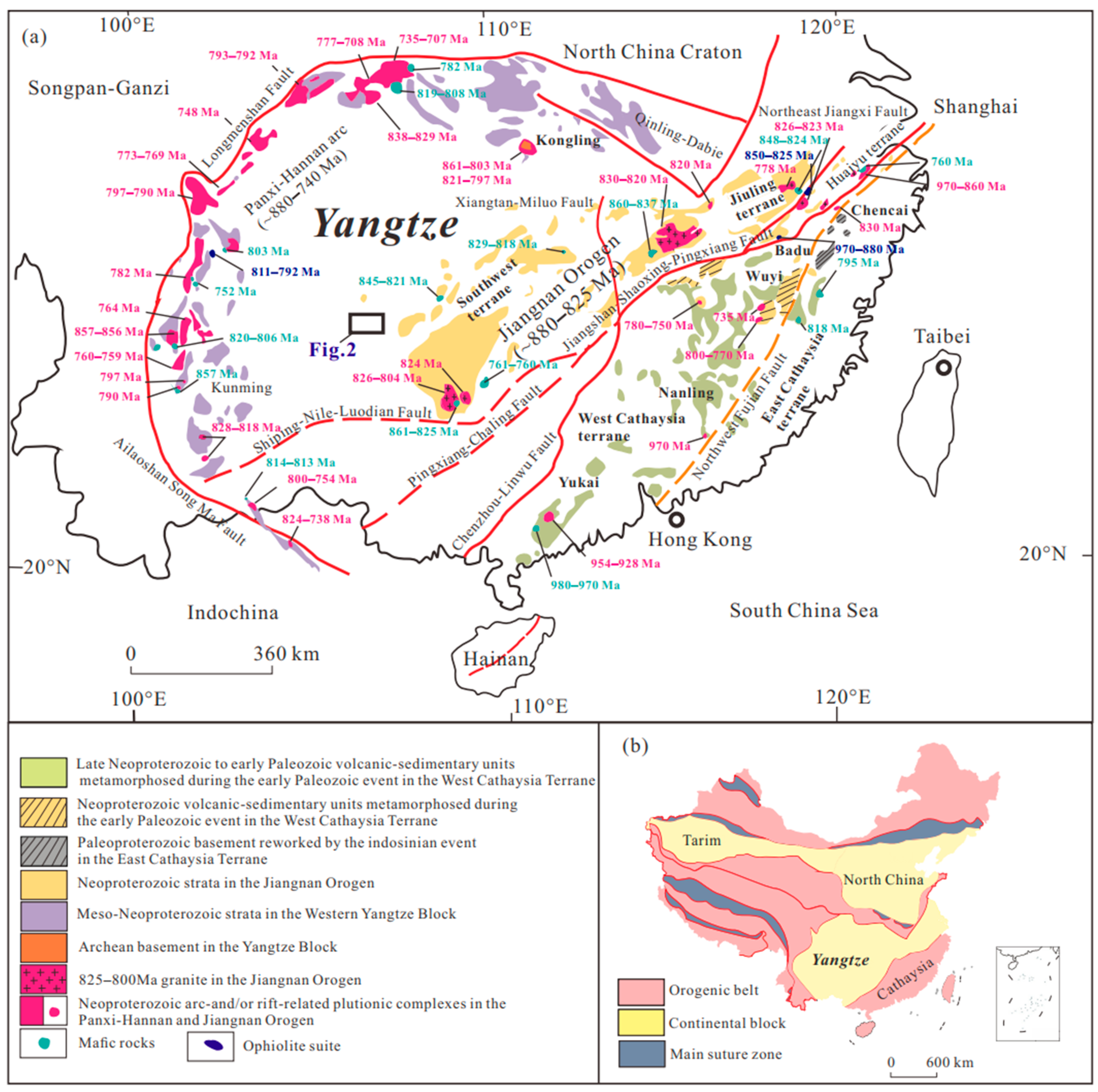
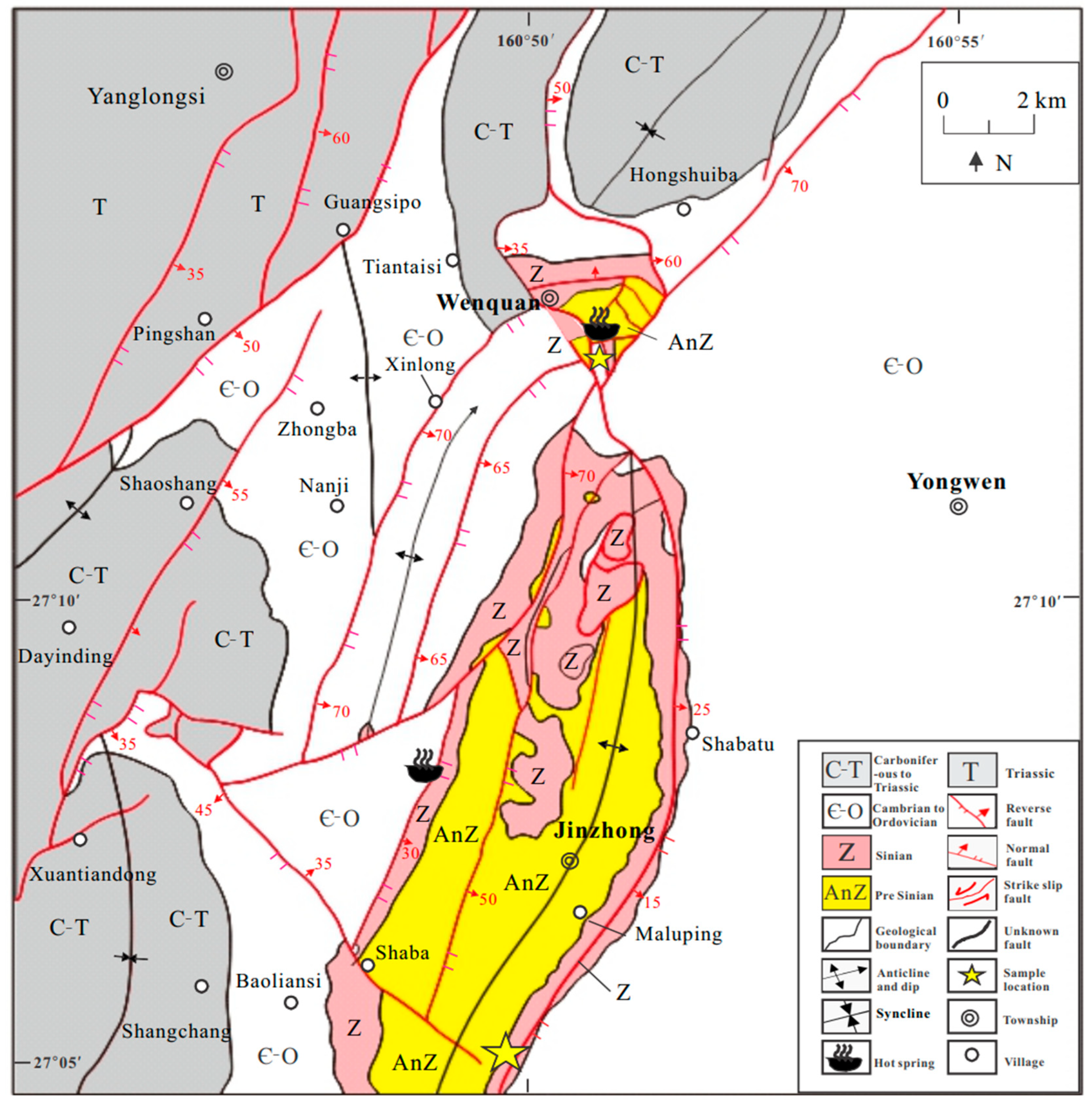

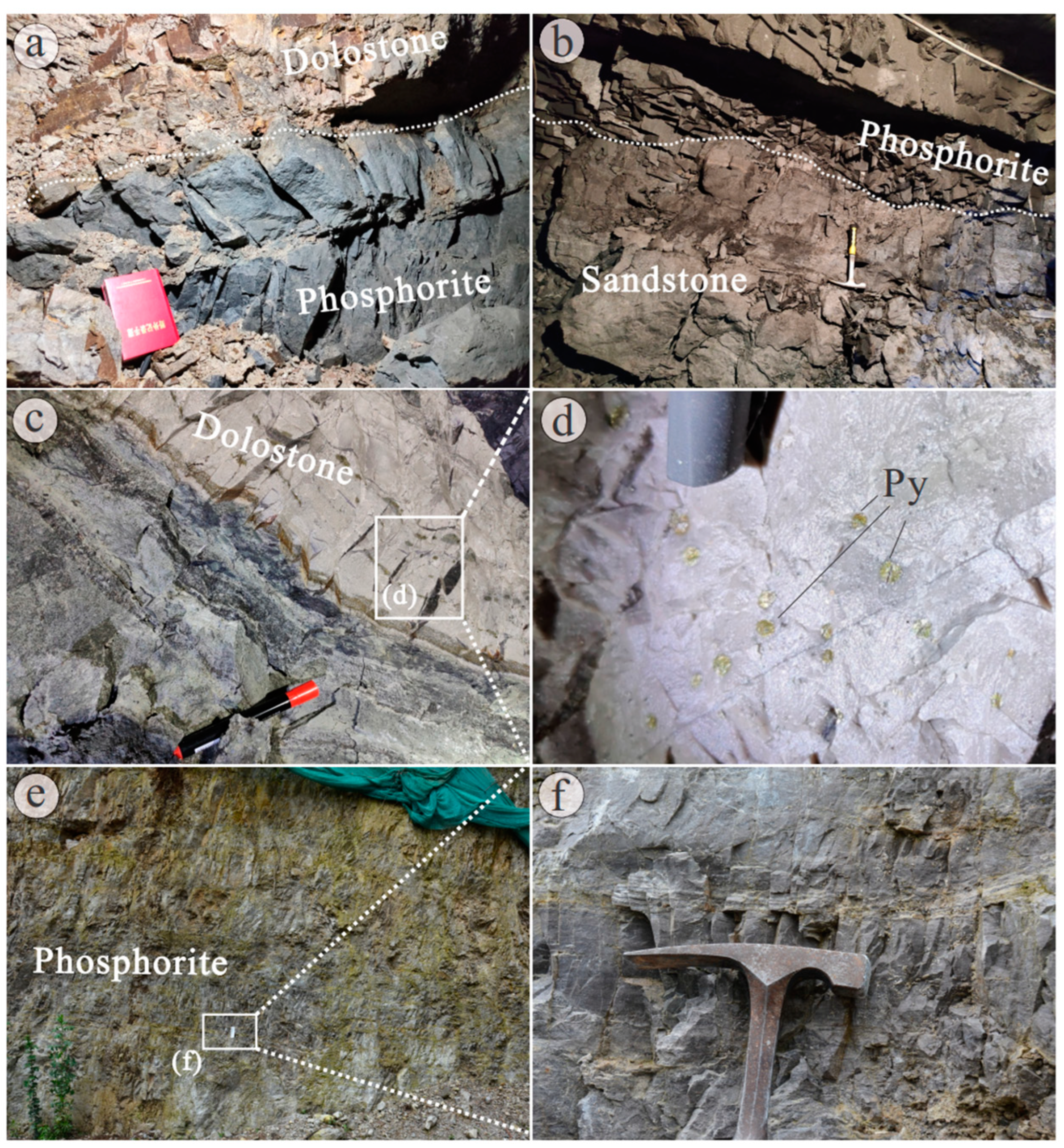
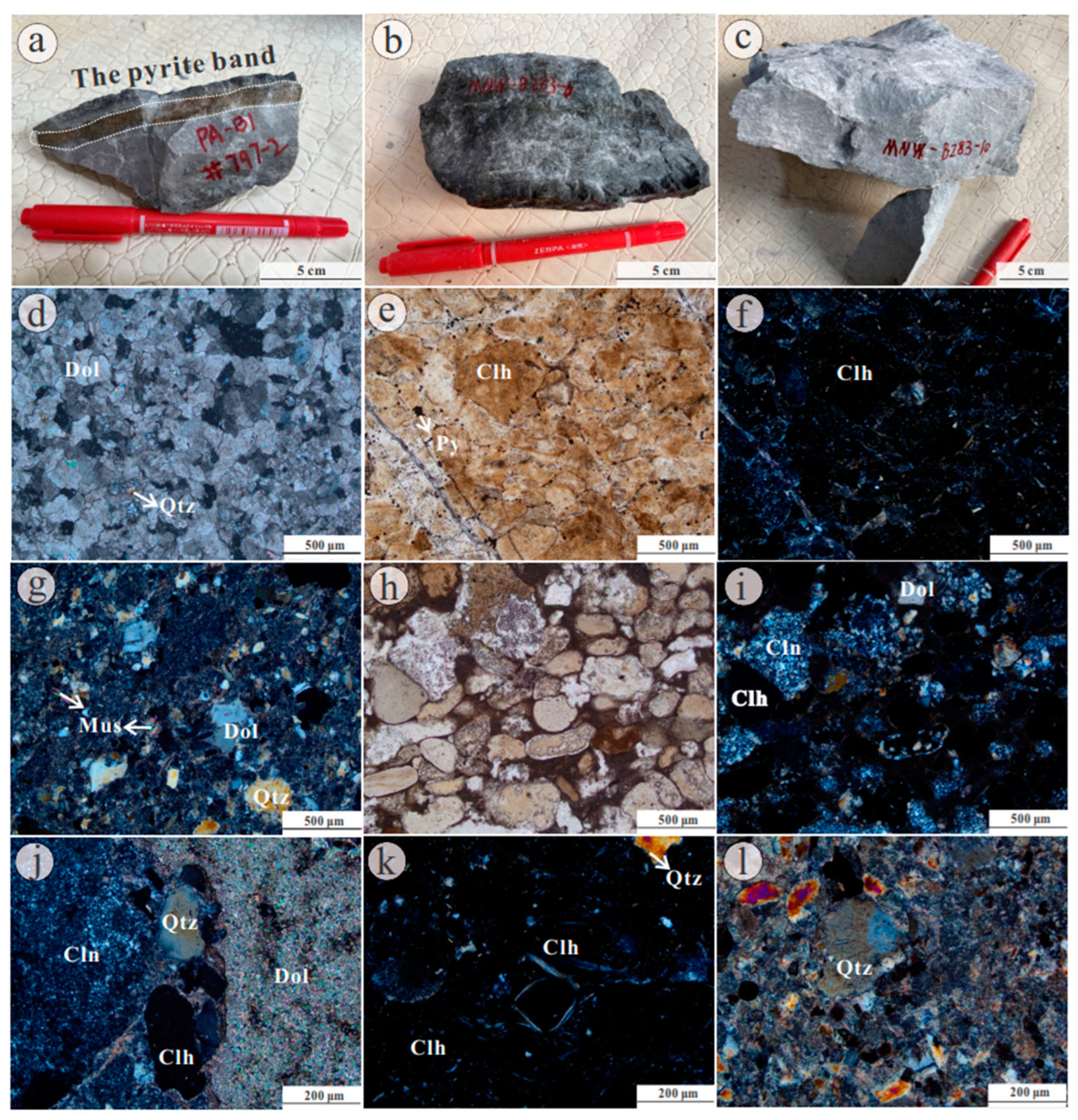
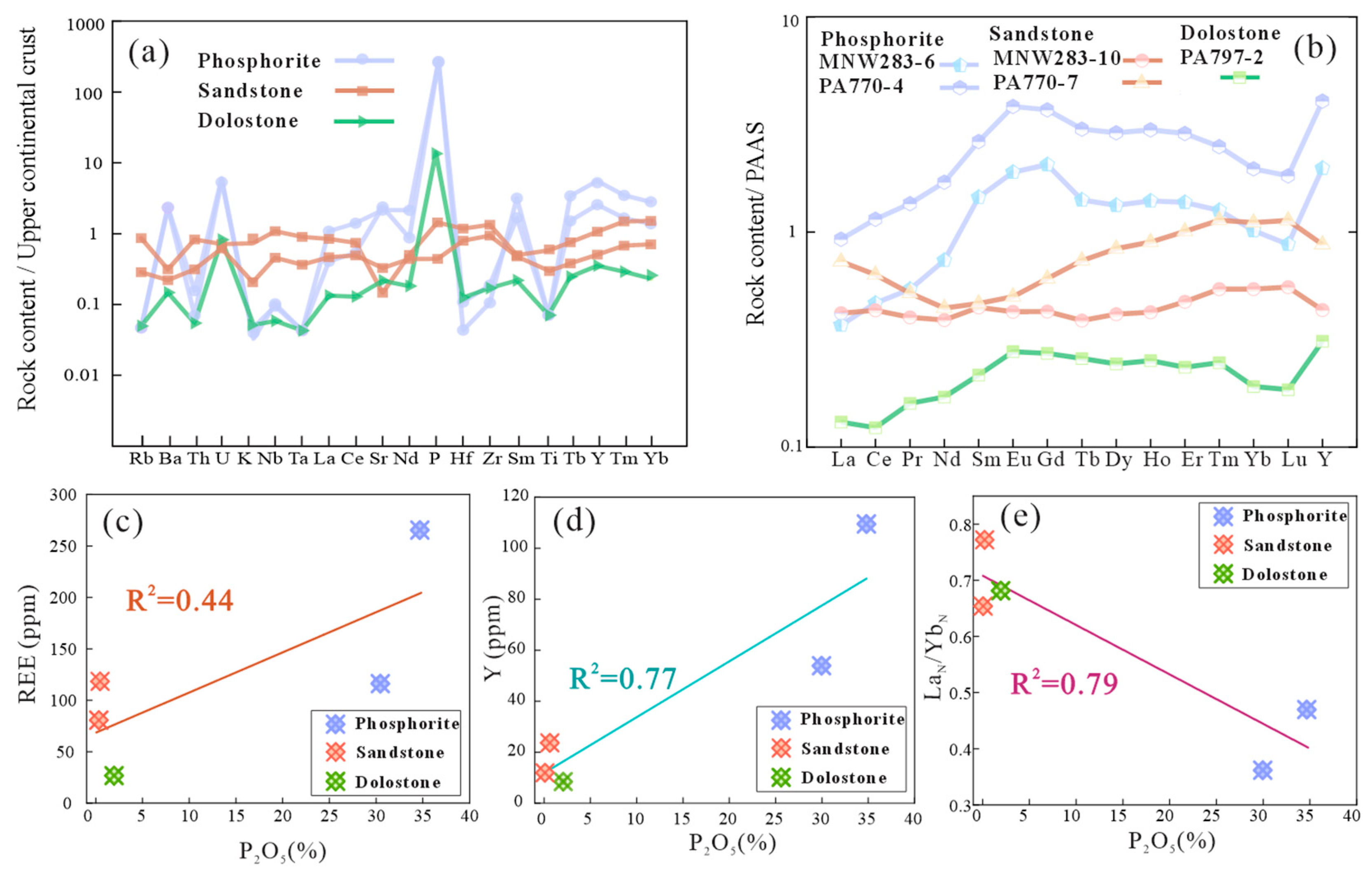
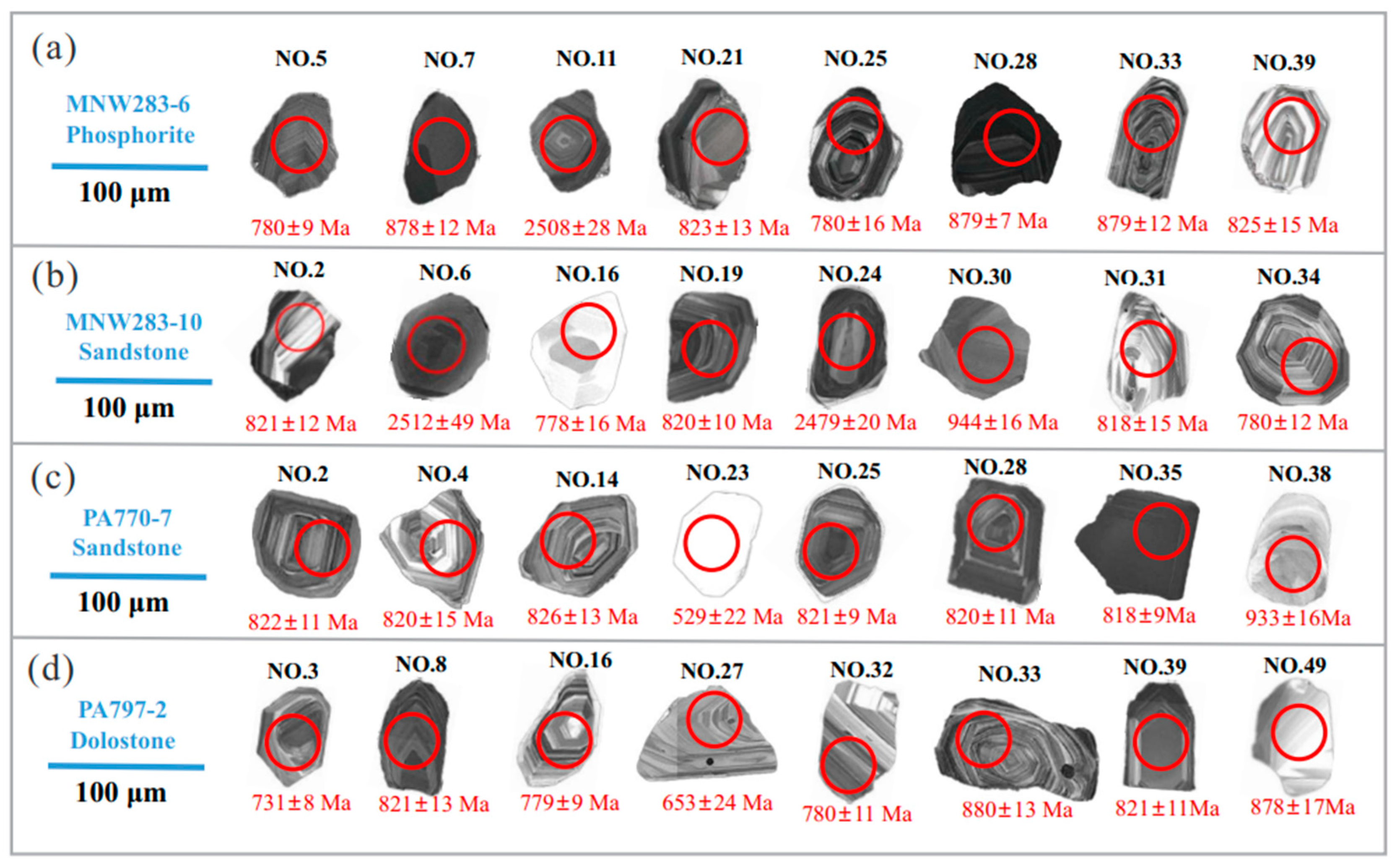
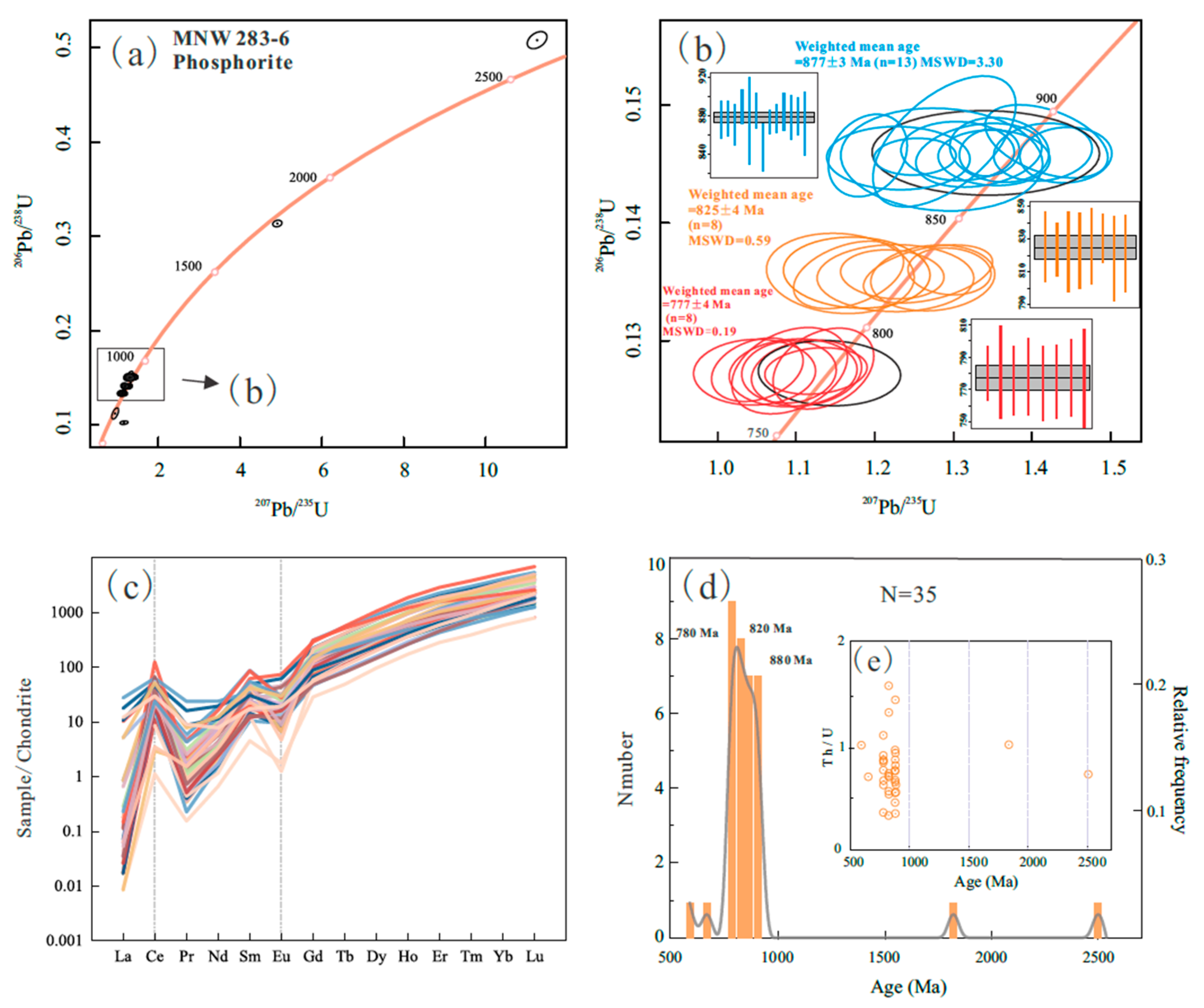
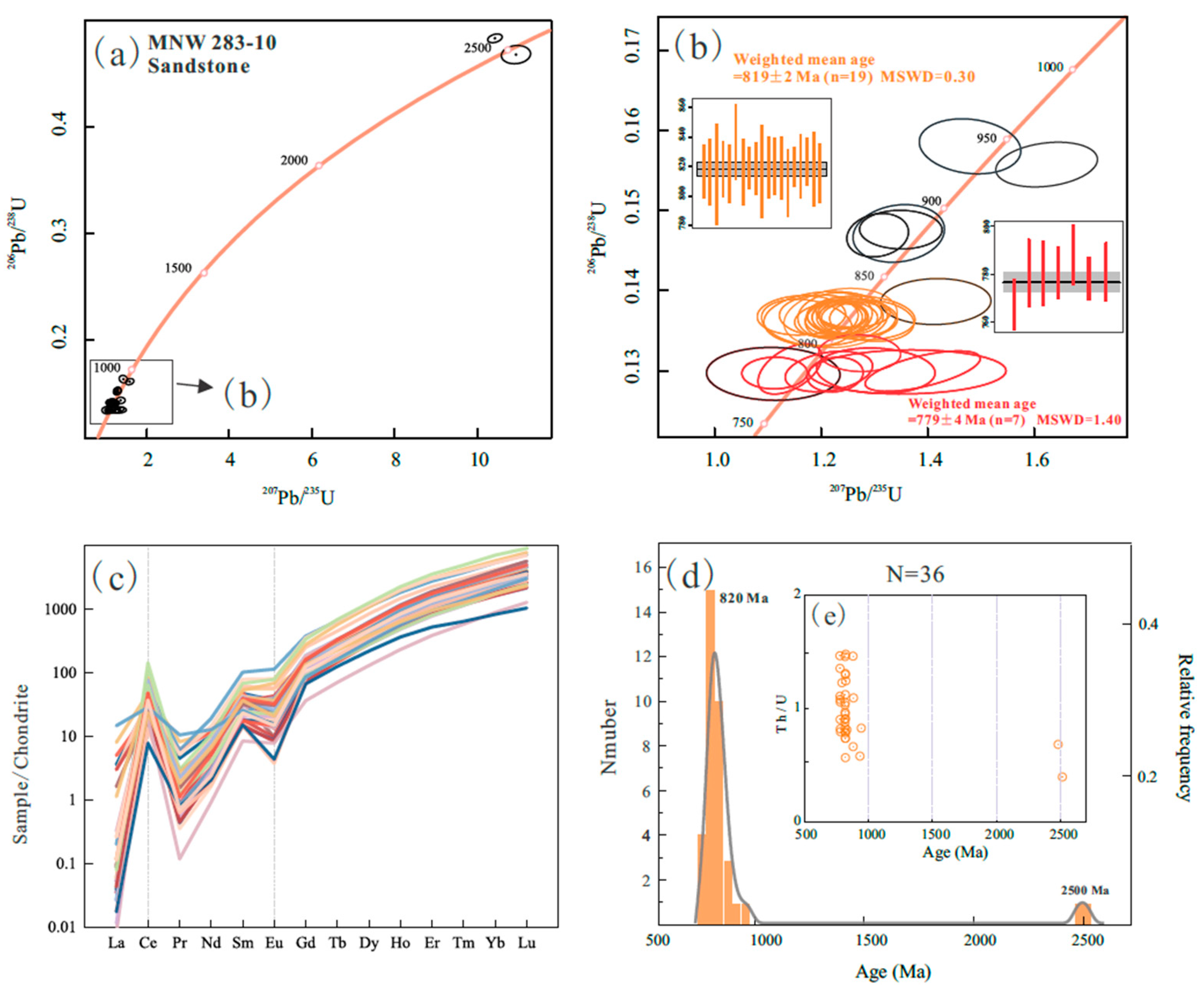
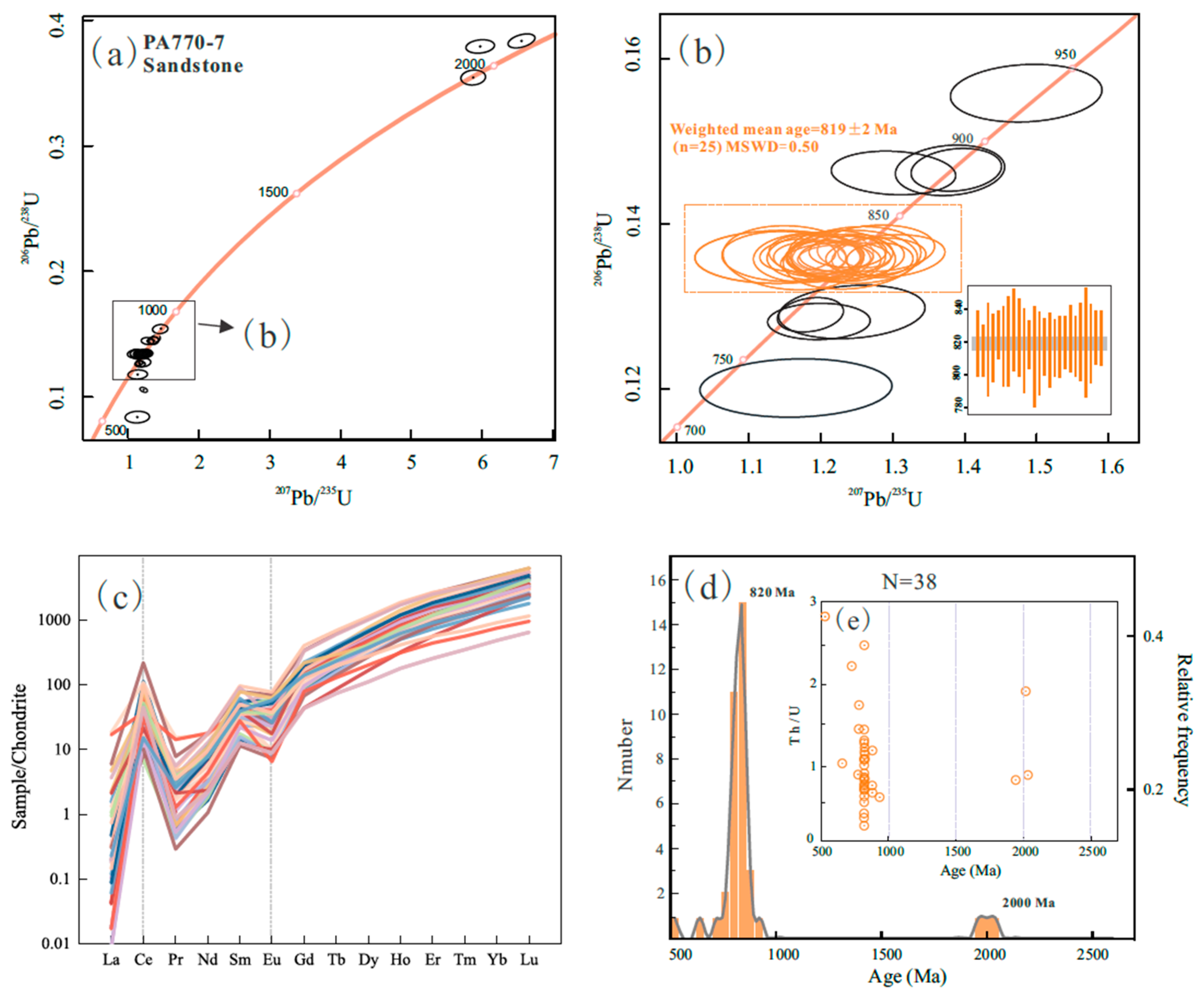
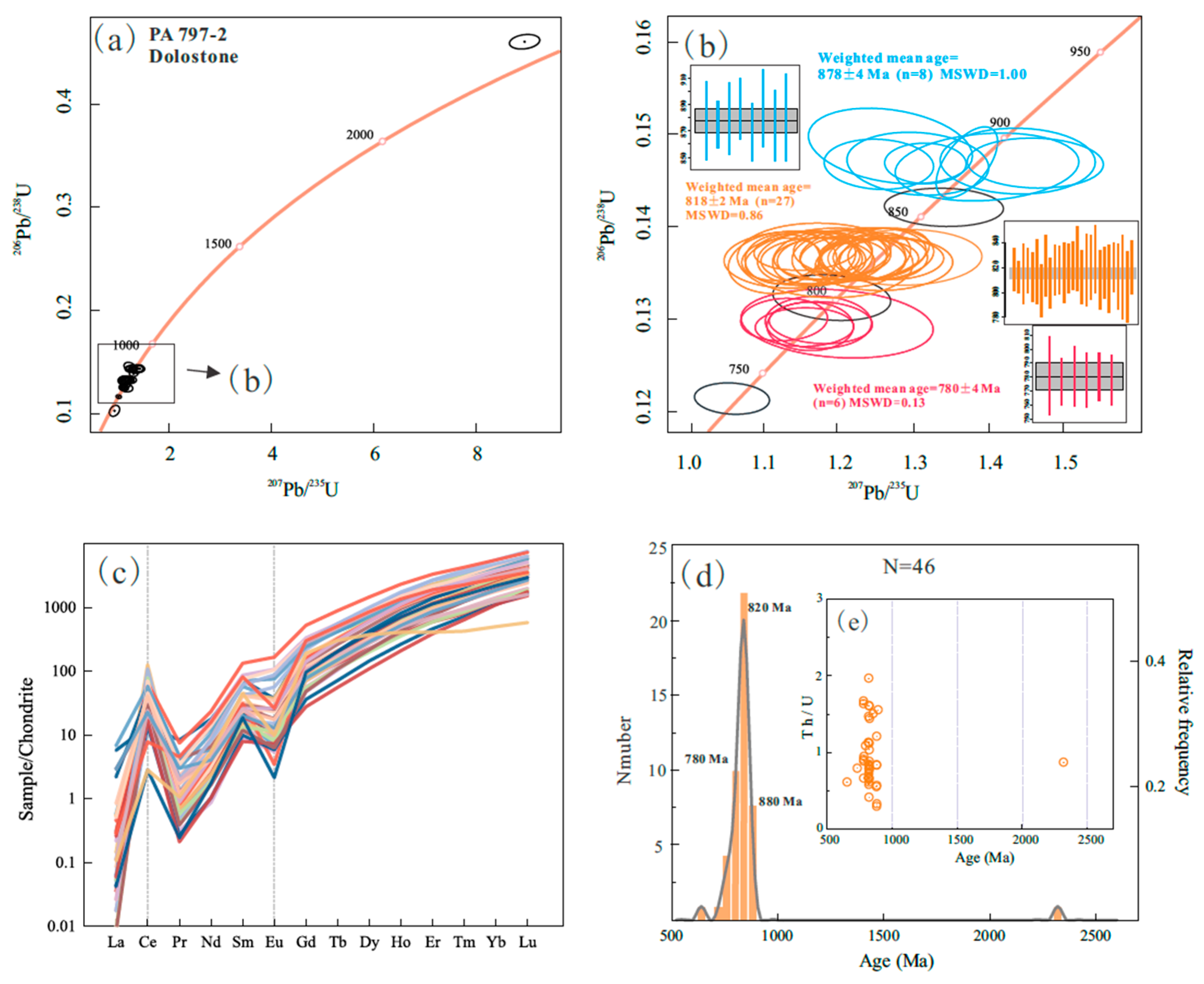
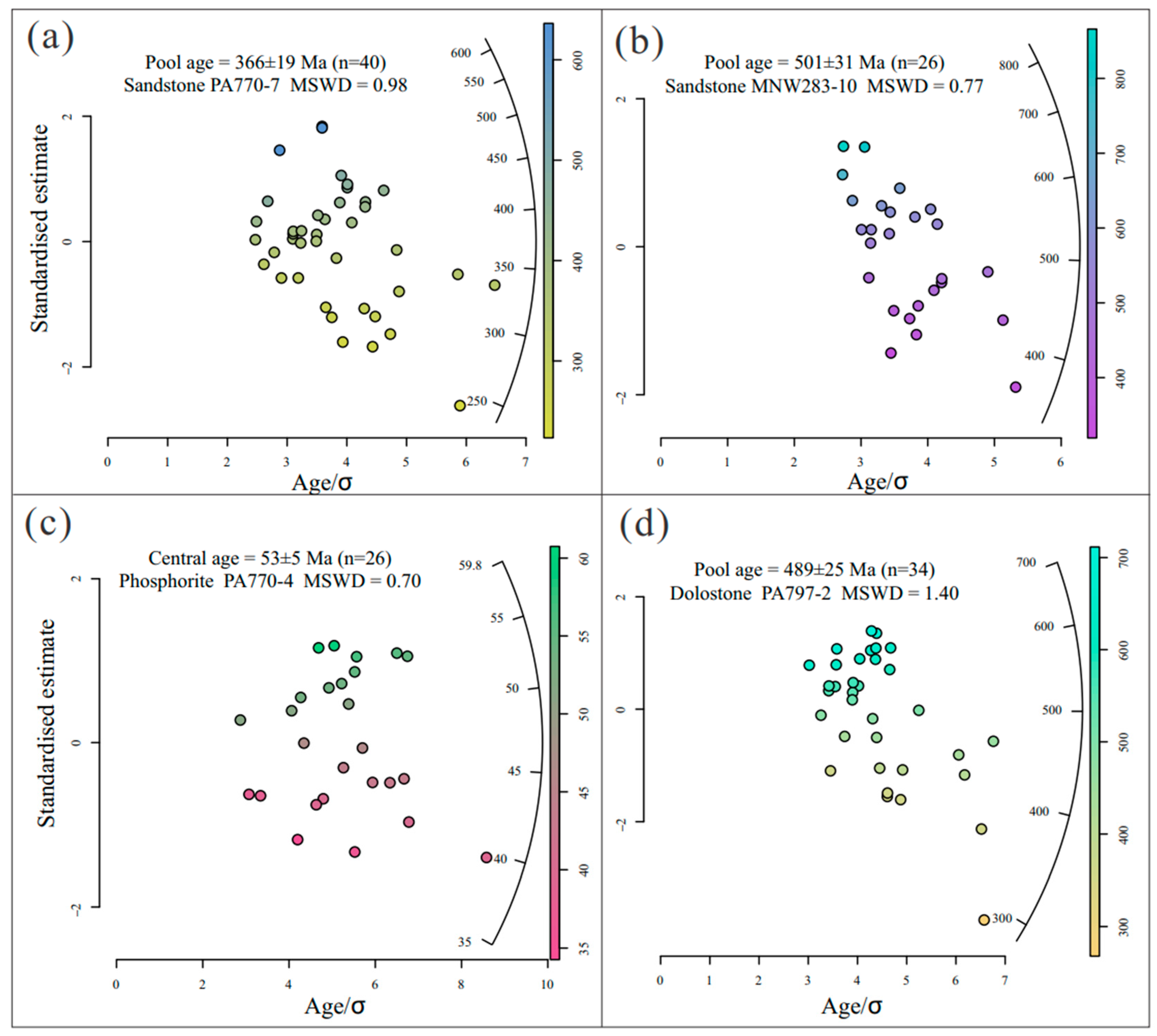

| Samples | Rock Type | Al2O3 | BaO | CaO | TFe2O3 | K2O | MgO | MnO | Na2O | P2O5 | SiO2 | SO3 | SrO | TiO2 | LOI |
|---|---|---|---|---|---|---|---|---|---|---|---|---|---|---|---|
| MNW283-6 | Phosphorite | 2.96 | 0.17 | 41.70 | 1.78 | 0.21 | 1.15 | 0.04 | 0.04 | 30.10 | 18.44 | 3.63 | 0.09 | 0.04 | 2.96 |
| PA770-4 | Phosphorite | 1.93 | 0.18 | 48.10 | 0.60 | 0.19 | 0.18 | 0.04 | 0.24 | 34.80 | 10.14 | 1.43 | 0.08 | 0.04 | 1.93 |
| MNW283-10 | Sandstone | 3.50 | 0.02 | 20.00 | 1.03 | 1.07 | 14.30 | 0.45 | 0.03 | 0.05 | 26.56 | 0.97 | 0.01 | 0.23 | 31.41 |
| PA770-7 | Sandstone | 10.08 | 0.03 | 2.14 | 2.10 | 3.10 | 1.92 | 0.04 | 0.02 | 0.30 | 74.42 | 2.68 | 0.01 | 0.50 | 4.71 |
| PA797-2 | Dolostone | 0.78 | 0.02 | 21.90 | 12.58 | 0.25 | 13.70 | 0.24 | 0.07 | 2.08 | 12.10 | 23.60 | 0.02 | 0.04 | 15.85 |
| Samples | MNW283-6 | PA770-4 | MNW283-10 | PA770-7 | PA797-2 |
|---|---|---|---|---|---|
| Rock Type | Phosphorite | Phosphorite | Sandstone | Sandstone | Dolostone |
| Li | 2.10 | 12.10 | 11.00 | 24.90 | 3.10 |
| Be | 0.32 | 1.61 | 0.59 | 1.27 | 0.38 |
| Sc | 0.90 | 1.50 | 2.60 | 5.90 | 1.00 |
| V | 16.00 | 5.00 | 51.00 | 36.00 | 8.00 |
| Cr | 9.00 | 9.00 | 11.00 | 25.00 | 5.00 |
| Co | 29.60 | 3.00 | 8.60 | 18.80 | 4.30 |
| Ni | 10.30 | 2.60 | 5.20 | 11.90 | 3.60 |
| Cu | 564.00 | 22.70 | 7.30 | 119.00 | 20.60 |
| Zn | 54.00 | 4.00 | 15.00 | 15.00 | 81.00 |
| Ga | 1.40 | 1.00 | 5.30 | 11.90 | 0.90 |
| Rb | 5.10 | 5.10 | 27.50 | 77.20 | 5.40 |
| Sr | 758.00 | 690.00 | 119.00 | 56.10 | 81.20 |
| Mo | 3.47 | 0.96 | 1.35 | 0.55 | 1.66 |
| Cd | 0.11 | 0.02 | 0.31 | 0.02 | 0.52 |
| In | 0.048 | 0.005 | 0.066 | 0.037 | 0.083 |
| Sb | 17.30 | 0.73 | 0.45 | 0.69 | 1.48 |
| Cs | 1.18 | 0.50 | 3.71 | 10.85 | 0.73 |
| Ba | 1445.00 | 1465.00 | 160.50 | 224.00 | 110.00 |
| W | 1.50 | 0.50 | 1.40 | 1.70 | 0.20 |
| Tl | 1.50 | 0.10 | 0.27 | 0.48 | 0.20 |
| Pb | 29.50 | 6.40 | 7.00 | 8.00 | 290.00 |
| U | 14.35 | 15.30 | 1.82 | 2.07 | 2.38 |
| Nb | 1.50 | 1.40 | 6.10 | 13.60 | 0.90 |
| Ta | 0.05 | 0.05 | 0.37 | 0.86 | 0.05 |
| Zr | 43.00 | 25.00 | 192.00 | 266.00 | 39.00 |
| Hf | 0.70 | 0.30 | 4.50 | 6.50 | 0.80 |
| La | 14.10 | 35.40 | 16.00 | 27.80 | 5.00 |
| Ce | 37.10 | 91.20 | 34.40 | 50.40 | 9.80 |
| Pr | 4.78 | 11.95 | 3.54 | 4.58 | 1.41 |
| Nd | 25.00 | 57.70 | 13.20 | 15.00 | 5.80 |
| Sm | 8.05 | 14.60 | 2.48 | 2.58 | 1.20 |
| Eu | 2.05 | 4.14 | 0.46 | 0.54 | 0.30 |
| Gd | 9.57 | 17.20 | 1.99 | 2.83 | 1.27 |
| Tb | 1.09 | 2.33 | 0.30 | 0.57 | 0.20 |
| Dy | 6.23 | 13.55 | 1.94 | 3.91 | 1.14 |
| Ho | 1.38 | 2.96 | 0.42 | 0.89 | 0.25 |
| Er | 3.91 | 8.18 | 1.35 | 2.87 | 0.67 |
| Tm | 0.51 | 1.01 | 0.22 | 0.46 | 0.10 |
| Yb | 2.86 | 5.54 | 1.53 | 3.12 | 0.54 |
| Lu | 0.38 | 0.79 | 11.70 | 23.60 | 8.40 |
| Y | 53.40 | 109.50 | 1.53 | 3.12 | 0.54 |
| Samples | Rock Type | n | ρs (105/cm2) | NS | ρi (105/cm2) | Ni | Nd | P(χ2) (%) | Central Age (±1σ) (Ma) | Pool Age (±1σ) (Ma) |
|---|---|---|---|---|---|---|---|---|---|---|
| MNW283-10 | Sandstone | 26 | 235.82 | 3454 | 14.01 | 410 | 7661 | 78.80 | 501 ± 31 | 501 ± 31 |
| PA770-7 | Sandstone | 40 | 204.98 | 4695 | 13.10 | 720 | 7661 | 51.20 | 366 ± 20 | 366 ± 19 |
| PA797-2 | Dolostone | 34 | 151.90 | 6152 | 14.93 | 802 | 7661 | 5.80 | 489 ± 28 | 489 ± 25 |
| PA770-4 | Phosphorite | 26 | 84.91 | 1636 | 12.43 | 1685 | 7661 | 0 | 53 ± 5 | 53 ± 3 |
Disclaimer/Publisher’s Note: The statements, opinions and data contained in all publications are solely those of the individual author(s) and contributor(s) and not of MDPI and/or the editor(s). MDPI and/or the editor(s) disclaim responsibility for any injury to people or property resulting from any ideas, methods, instructions or products referred to in the content. |
© 2024 by the authors. Licensee MDPI, Basel, Switzerland. This article is an open access article distributed under the terms and conditions of the Creative Commons Attribution (CC BY) license (https://creativecommons.org/licenses/by/4.0/).
Share and Cite
Song, Y.; Li, T.; Zhou, J.; Zhu, D.; Xiao, L. Zircon U-Pb and Fission-Track Chronology of the Kaiyang Phosphate Deposit in the Yangtze Block: Implications for the Rodinia Supercontinent Splitting and Subsequent Thermal Events. Minerals 2024, 14, 585. https://doi.org/10.3390/min14060585
Song Y, Li T, Zhou J, Zhu D, Xiao L. Zircon U-Pb and Fission-Track Chronology of the Kaiyang Phosphate Deposit in the Yangtze Block: Implications for the Rodinia Supercontinent Splitting and Subsequent Thermal Events. Minerals. 2024; 14(6):585. https://doi.org/10.3390/min14060585
Chicago/Turabian StyleSong, Yina, Tianqi Li, Jiayi Zhou, Debin Zhu, and Lingling Xiao. 2024. "Zircon U-Pb and Fission-Track Chronology of the Kaiyang Phosphate Deposit in the Yangtze Block: Implications for the Rodinia Supercontinent Splitting and Subsequent Thermal Events" Minerals 14, no. 6: 585. https://doi.org/10.3390/min14060585






